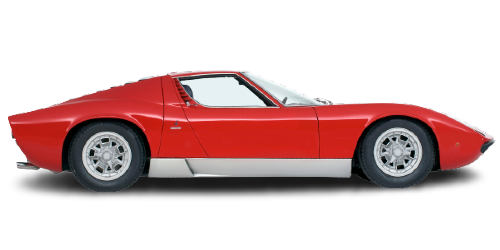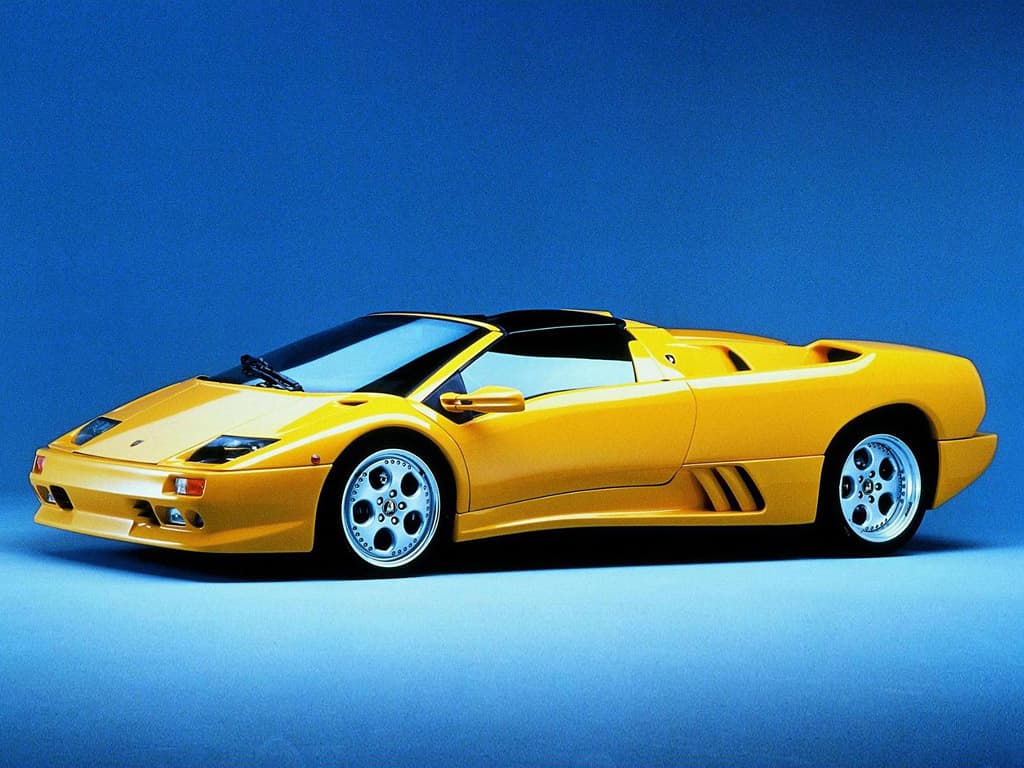Lamborghini built a total of 275 Miura before they decided it was time to introduce a first evolution in 1969, Lamborghini showed the first revision of the successful Miura, named the Miura S, with the ‘S’ for Spinto.
Over the previous year, Dallara and his team had been working on perfecting this amazing automobile, Bob Wallace was doing the field work by testing the cars on the road, while Dallara was working on the design underneath the sensual bodywork.
A lot of testing was done with various types of tires, Lamborghini and Pirelli always had a very close working relationship and they both benefited from this. The new Miura S would have a modified rear suspension receiving the then new, state of the art series 70 Pirelli Cinturato radials.
But the most important change over the very first models was the use of heavier-gauge steel on the chassis, starting with Miura chassis nr. 125 on (according to Lamborghini records), the metal thickness was brought up to 1 mm from 0.9 mm to avoid flexing at high cornering speeds.
This higher resistance chassis would be required because the Miura S could deliver no less than 370 Bhp at 7700 rpm on the rear wheels. The combustion chambers were reshaped, higher-lift cams and larger carburetors on fatter manifolds boosted power to a claimed 370 bhp.
You might expect the new Miura S to be faster than it’s P400 sibling, but unfortunately the new tires, which did help road holding and overall handling, absorbed most of this power increase.
Individual testing unveiled a top speed of the Miura S between 270 and 280 Km/h (169 to 173 Mph), later it would become obvious the Miura S was one of the fastest Lamborghini ever, it was even faster than the wild Countach S series, which did boast massive tires at the rear and big wings and spoilers, but these also increased drag, so the Miura S was quicker. This was even obvious when measuring the standing Km, which the Miura S could reach in only 24.1 to 26 seconds. The quarter Mile was reached in a mere 13.9 seconds at a speed of 107.5 Mph a time that would be very hard to beat back in the late Sixties or even the early Seventies.
During the S model production, ventilated disc brakes were introduced, still utilizing the well-known Girling calipers, but now using new brake pads.
Power windows soon became standard too, while the two handles to release the engine-cover were converted to only one unit, the two handles on the early cars were a real annoyance, they had to be pulled simultaneously to release the hood so you always needed two people to open the rear section to reach the V12 power plant.
On the inside, a lockable glove-compartment would be installed, the wood-rimmed steering wheel was replaced by a leather wrapped one, although this was also seen on some late, pre-S models. The roof mounted central console was redesigned to improve cockpit ventilation and you could even order an optional radio if the sound of the engine would ever bore you.
Other options were a non-standard color (100.000 Liras), metallic color (200.000 Liras), VIP Interior in leather (200.000 Liras), a set of suitcases (180.000 Liras), VIP Pearlized colors (450.000 Liras), a tree-point seat belt (40.000 Liras), air-conditioning (500.000 Liras) and for a right-hand drive car you had to add another 500.000 Liras, so very few RHD Miura were ever built.
We must admit that the air conditioning in the Miura never really was adequate for this car, the engine was very close to the driver and passenger and the steep windshield would also heat up the interior when driving in the sun to such a degree that the air conditioning couldn’t keep feeding cold air fast enough.
Do note that the leather upholstery was still an option on the Miura S, although many cars were ordered with it, the earlier P400 could be fitted with vinyl seats, something better avoided with such a hot engine only inches behind your ears.
To be able to sell the Miura in the United States, the toggle-switches were replaced by rocker-types, and a passenger grab handle was installed, the speedometer now only went up to 190 mph for non-metricated countries, on the earlier cars this one was calibrated for 200 mph.
The exterior was wisely left alone, only small details were altered, the head lamps now would be raised without their black fins, on the early cars these too lifted up into the air, resulting in a rather awkward look.
Another change was the use of a chrome finish for the headlight and windscreen frames which were black on the early Miura. Do note however that the very first Miura S still had the black surrounds mounted, making it very difficult to recognize the S model next to the original P400.
Naturally there was a stylish ‘S’ at the rear of the car, but that could be added later on too, and since many Miura had a rather eventful life, it isn’t impossible that many P400 were later converted into S-models, or at least received the updates from the S series.
These days, when an owner is restoring his original Miura it is wise to either reinforce the chassis or select thicker steel to restore the chassis anyway, making the difference between the P400 and the P400 S even smaller.
During the production of the Miura S some modifications were executed, obviously the Miura remained a work in progress, constantly being improved as more cars were built.
One of these ‘production’ modifications was the use of a 770 Watt alternator replacing the early 450 Watt unit, also the ignition and carburetors were slightly modified between 1968 and 1971.
On the transmission the Fabri (or Hardy Spicer) splined drive shaft system was replaced by Unicardin (or Lobro) constant velocity joints. These constant velocity joints did require a different setting for the Koni shocks.
To reduce squat under hard acceleration the mounting points for the rear A-arm were moved, but one problem remained on the Miura S, when cornering very fast you ran the risk of pulling engine oil to one side, which could damage the engine beyond repair.
The Miura actually used the same oil for both the engine and the gearbox, later the SV would receive an optional split sump which would remedy this problem, but only a handful would be built with this option.
However all these extra add-ons increased the total weight of the Miura, the first S models put only 1125 Kg on the scales, while the latest S model ‘grew’ to 1250 Kg in total, and this was dry-weight. But the Miura S would be succeeded by an even better Bull, the impressive SV edition, which came to be considered as the ultimate Miura, it took over from the S model after 338 units were built, a little more than the 275 units of the original P400 Miura.
| Specification | Details |
|---|---|
| Production Years | 1968 – 1971 |
| Units Produced | Approximately 338 |
| Layout | Mid-engine, Rear-Wheel Drive |
| Body Style | 2-door coupé |
| Engine | 3.9L V12 |
| Power Output | 370 hp (276 kW) |
| Torque | 286 lb-ft (388 Nm) |
| Transmission | 5-speed manual |
| Top Speed | Approximately 177 mph (285 km/h) |
| Acceleration (0-60 mph) | Approximately 5.5 seconds |
| Weight | 1298 kg (2860 lbs) |



